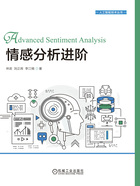
参考文献
[1]LIU B. Synthesis lectures on human language technologies: sentiment analysis and opinion mining[M/OL]. Morgan & Claypool Publishers, 2012. https://doi.org/10.2200/S00416ED1V01Y201204HLT016.
[2]徐琳宏,林鸿飞,赵晶.情感语料库的构建和分析[J].中文信息学报,2008.
[3]WANG X, WEI F, LIU X, et al. Topic sentiment analysis in twitter: a graph-based hashtag sentiment classification approach[C/OL]//MACDONALD C, OUNIS I, RUTHVEN I. Proceedings of the 20th ACM Conference on Information and Knowledge Management, CIKM 2011, Glasgow, United Kingdom, October 24-28, 2011. ACM, 2011: 1031-1040. https://doi.org/10.1145/2063576.2063726.
[4]HU X, TANG L, TANG J, et al. Exploiting social relations for sentiment analysis in microblogging[C/OL]//LEONARDI S, PANCONESI A, FERRAGINA P, et al. Sixth ACM International Conference on Web Search and Data Mining, WSDM 2013, Rome, Italy, February 4-8, 2013. ACM, 2013: 537-546. https://doi.org/10.1145/2433396.2433465.
[5]ZHOU S, CHEN Q, WANG X. Active deep networks for semi-supervised sentiment classification[C/OL]//HUANG C, JURAFSKY D. COLING 2010, 23rd International Conference on Computational Linguistics, Posters Volume, 23-27 August 2010, Beijing, China. Chinese Information Processing Society of China, 2010: 1515-1523. https://aclanthology.org/C10-2173/.
[6]SOCHER R, PERELYGIN A, WU J, et al. Recursive deep models for semantic compositionality over a sentiment treebank[C/OL]//Proceedings of the 2013 Conference on Empirical Methods in Natural Language Processing, EMNLP 2013, 18-21 October 2013, Grand Hyatt Seattle, Seattle, Washington, USA, A meeting of SIGDAT, a Special Interest Group of the ACL. ACL, 2013: 1631-1642. https://aclanthology.org/D13-1170/.
[7]李寿山.情感文本分类方法研究[J]. 2008.
[8]谭松波.高性能文本分类算法研究[D].中国科学院研究生院,2006.
[9]STAIANO J, GUERINI M. Depeche mood: a lexicon for emotion analysis from crowd annotated news[C]//Proceedings of the 52nd Annual Meeting of the Association for Computational Linguistics(Volume 2: Short Papers). [S.l.: s.n.], 2014: 427-433.
[10]RAO Y, XIE H, LI J, et al. Social emotion classification of short text via topic-level maximum entropy model[J/OL]. Inf. Manag., 2016, 53(8): 978-986. https://doi.org/10.1016/j.im.2016.04.005.
[11]KESHTKAR F, INKPEN D. A hierarchical approach to mood classification in blogs[J/OL]. Nat. Lang. Eng., 2012, 18(1): 61-81. https://doi.org/10.1017/S1351324911000118.
[12]ORIMAYE S O, ALHASHMI S M, SIEW E. Can predicate-argument structures be used for contextual opinion retrieval from blogs?[J/OL]. World Wide Web, 2013, 16(5-6): 763-791. https://doi.org/10.1007/s11280-012-0170-8.
[13]BEINEKE P, HASTIE T, MANNING C, et al. Exploring sentiment summarization[C]//Proceedings of the AAAI spring symposium on exploring attitude and affect in text: theories and applications: volume 39. [S.l.]: The AAAI Press Palo Alto, CA, 2004.
[14]BICKART B, SCHINDLER R M. Internet forums as influential sources of consumer information[J]. Journal of interactive marketing, 2001, 15(3): 31-40.
[15]ZHANG Y, LAI G, ZHANG M, et al. Explicit factor models for explainable recommendation based on phrase-level sentiment analysis[C/OL]//GEVA S, TROTMAN A, BRUZA P, et al. The 37th International ACM SIGIR Conference on Research and Development in Information Retrieval, SIGIR ’14, Gold Coast , QLD, Australia-July 06-11, 2014. ACM, 2014: 83-92. https://doi.org/10.1145/2600428.2609579.
[16]TURNEY P D. Thumbs up or thumbs down? semantic orientation applied to unsupervised classification of reviews[C/OL]//Proceedings of the 40th Annual Meeting of the Association for Computational Linguistics, July 6-12, 2002, Philadelphia, PA, USA. ACL, 2002: 417-424. https://aclanthology.org/P02-1053/. DOI: 10.3115/1073083.1073153.
[17]TUMASJAN A, SPRENGER T O, SANDNER P G, et al. Predicting elections with twitter: what 140 characters reveal about political sentiment[C/OL]//COHEN W W, GOSLING S. Proceedings of the Fourth International Conference on Weblogs and Social Media, ICWSM 2010, Washington, DC, USA, May 23-26, 2010. The AAAI Press, 2010. http://www.aaai.org/ocs/index.php/ICWSM/ICWSM10/paper/view/1441.
[18]BOLLEN J, MAO H, ZENG X. Twitter mood predicts the stock market[J/OL]. J. Comput. Sci., 2011, 2(1): 1-8. https://doi.org/10.1016/j.jocs.2010.12.007.
[19]HUR M, KANG P, CHO S. Box-office forecasting based on sentiments of movie reviews and independent subspace method[J/OL]. Inf. Sci., 2016, 372: 608-624. https://doi.org/10.1016/j.ins.2016.08.027.
[20]GOLDER S A, MACY M W. Diurnal and seasonal mood vary with work, sleep, and daylength across diverse cultures[J]. Science, 2011, 333(6051): 1878-1881.
[21]KIM S, LEE J, LEBANON G, et al. Estimating temporal dynamics of human emotions[C/OL]//BONET B, KOENIG S. Proceedings of the Twenty-Ninth AAAI Conference on Artificial Intelligence, January 25-30, 2015, Austin, Texas, USA. AAAI Press, 2015: 168-174. http://www.aaai.org/ocs/index.php/AAAI/AAAI15/paper/view/9682.
[22]ZHOU X, WAN X, XIAO J. Collective opinion target extraction in chinese microblogs[C/OL]//Proceedings of the 2013 Conference on Empirical Methods in Natural Language Processing, EMNLP 2013, 18-21 October 2013, Grand Hyatt Seattle, Seattle, Washington, USA, A meeting of SIGDAT, a Special Interest Group of the ACL. ACL, 2013: 1840-1850. https://aclanthology.org/D13-1189/.
[1]https://www.powerreviews.com/